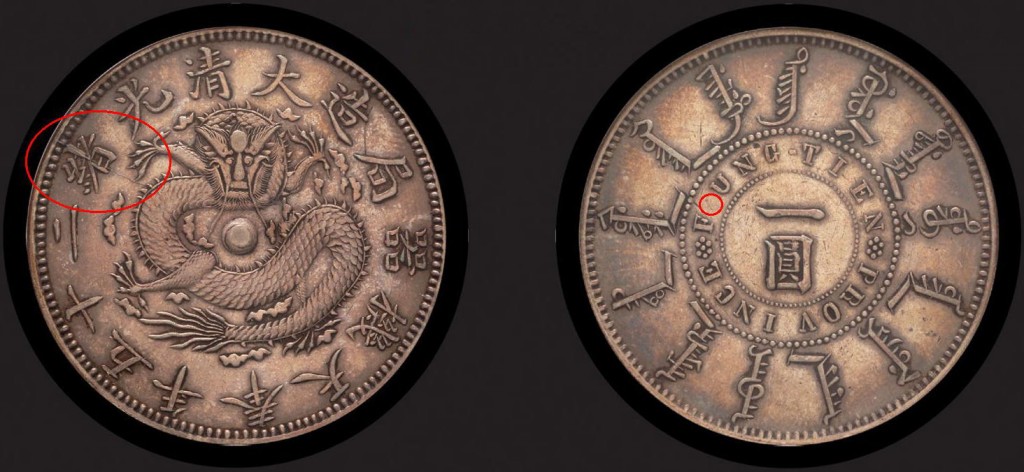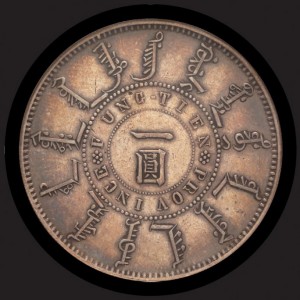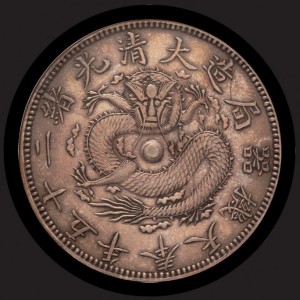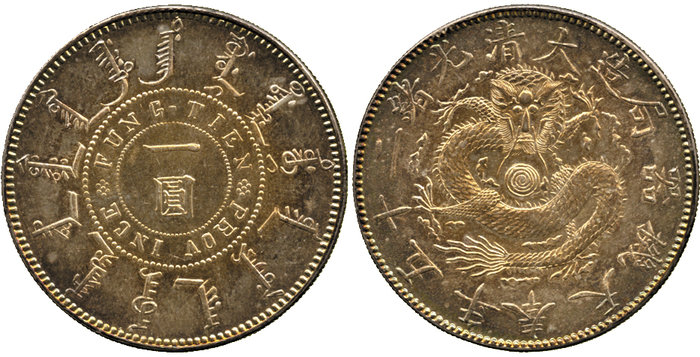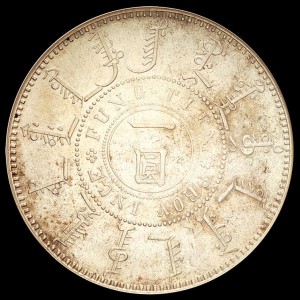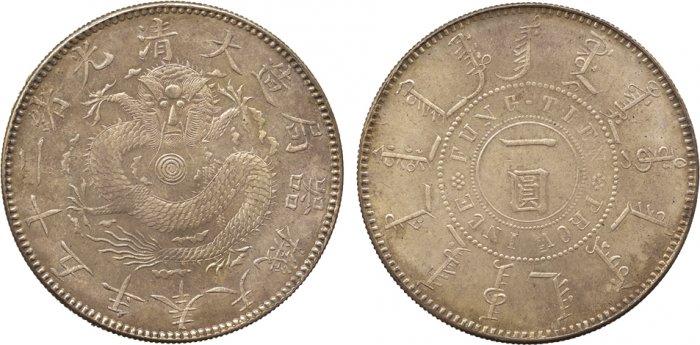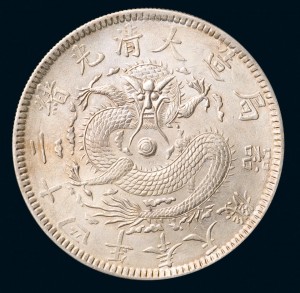I had previously written about the 25th year of Kwang Hsu Fengtien dollars, which is one of my favourite Chinese silver dollars. I would like to complete my previous article by introducing another interesting die variation, which brings the total to 4 main variations for this one year type coin.
1st variation: Smiling Dragon, Pearl Circle (细龙珠圈)
This is most likely the first variation produced. The style is very similar to the one of the previous year, and it is very well executed. However, die engraving is quite a technical art, and a small mistake can lead to damaged dies and coins defects. This particular variation was unfortunately afflicted with a die crack running through the 绪 character. The severity of the die crack varies depending on the time the coin was struck, but it is always present on genuine coins. You will also notice that the swirl on the fireball is weakly struck. On the reverse, there is a problem with typography (bad spacing between F and U) and weak strike (on G -).
2nd variation: Crude Dragon, Pearl Circle (粗龙珠圈)
This variation is a complete redesign of the previous one. It is likely that this pair of dies was made as soon as the defects of the previous one were known. Compared to its predecessor, it seems like a rushed job. The face of the dragon looks flat and crude compared to the first version. The spacing of the Chinese characters is unbalanced (局 and 造 are too close, 年 and 奉 as well), while the legend of the first version was evenly spaced. The reverse was improved though, the bad spacing in the English text was fixed and it is now clearly struck, however it was the turn of the pearl circle to suffer from weak strike.
3rd variation; Crude Dragon, Double Circle (粗龙双圈)
While overall the 25th year of Guang Xu Fengtien coins are rare, some variations are scarcer than others. The coins with a single circle of pearls are more common than the double circle variations. The first variation to present this double circle is actually an incremental revision of the 2nd variation. The obverse was reworked to correct the chinese characters spacing and slightly improve the dragon pattern, which remains cruder than the 1st design.
On the reverse, I suspect the solid circle was added while correcting the weak strike on the pearl circle. By superposing a pictures of the 2nd and 3rd variation, it is easy to see that the dragon pattern was heavily modified, but that the die for the reverse is virtually identical – only the circle was added. However, as seen above, it was now TIEN which was weakly struck…
4th variation: Smiling Dragon, Double Circle (细龙双圈)
This is the additional version that I want to introduce. It is in my opinion the most interesting variation for this coin. The reverse has been completely reworked, keeping the solid circle. The manchu script has been fixed, and the whole face is well struck.
However, a die crack appeared at 5 o’clock.
The dragon design has been updated as well, in the fine style of the 1st variation. Its face is artfully designed, in the fashion of previous Fengtien coins, with the smiling dragon seemingly flying toward the high relief fireball.
The dragon is much smaller than the one featured on the cruder variations, and the spacing of the Chinese legend has been improved as well, which makes this obverse much more balanced and good looking.
I believe this variation was the last silver dollar minted at the Fengtien machine bureau before the short lived 1903 dollar, four years later. Indeed, this particular design is often seen with a huge die crack on the reverse, and late samples seem to have been struck with very worn out and damaged dies. This leads me to believe no more dies were made afterward and the last ones were used until they broke down, their degradation mirroring the one of the political situation in the Fungtien province.
I recently acquired a new Chinese coin, struck over a century ago at the Fengtien arsenal mint in the nowadays Shenyang (沈阳) city. It is now one of the few cities minting coins for the People’s Bank of China, along with Shanghai and Shenzhen. Today one of the biggest cities of China and an industrial powerhouse, Shenyang can trace the beginning of its transformation in a heavy industry titan back to the establishment of the Fengtien machine bureau (奉天机器局) in the late Qing era.
The Ancestor of the Shenyang Mint: the Fengtien Machine Bureau
Created in 1897 at the instigation of the General Iktangga (依克唐阿), governor of the Fengtien province, the bureau was destined to modernize the provincial coinage. An early set of dies was commissionned from the Anqing (安庆) mint in Anhwei (安徽), and German-made steam-powered machinery were brought from Tianjin. The early test issues using the An Hui dies were denominated in maces and candareens, and were designed after the Kwantung dollar. With the success of the Peiyang arsenal dollars, subsequent issues were however redesigned and the first emission meant for circulation in 1898 features a reverse bearing the characteristic circular manchu writings in the style of the contemporary Beiyang coins.
The last emission, in 1899, has a very similar design. As far as I know, three dies were used for the 25th year of Guang Xu series. The coin I bought is of the first type, as seen below:
The first set of die used has a single dotted ring around the denomination on the reverse (单圈版 in Chinese). The reverse has an obvious error in the typography of the province name, with a huge empty space between the F and U of FUNG TIEN. The strike is also noticeably weak from the G to the T. On the obverse, this die is very different from the subsequent ones. The dragon face is beautiful, with some relief on the sides of the dragon nose and a large, “smiling” mouth. The fireball at the center is ornamented with a wide, incomplete spiral probably resulting from a weak strike.
The second strike features a new dragon design; the reverse issues were also partially fixed:
The province name on the reverse is now correctly typographied, but the strike is still weak on the area from the G to the T. The new dragon design is very different from the previous issue, with a flatter face and a thinner mouth. The spiral on the fireball is complete this time, running all the way to the center.
The last emission tries again to correct the problems of the reverse, keeping the new dragon design.
As seen here, the G and T are indeed slightly stronger, but the end of “TIEN” is weaker, while it was crisp in the previous strikes… It seems that like the Kiangnan mint, the early Shenyang mint had troubles with the die adjustement and thus produced weakly struck coins.
A solid circle was added around the denomination, inside the inner dotted circle.
This strike is known as the “Linear circle within dotted circle” die, or 双圈版 in Chinese.
After this third strike, the mint machinery was seized by the tsarist Russian army and the Shenyang machine bureau was burned down… The province of Fengtien (nowadays Liao Ning) was indeed going through dark times. Already the theater of the first Sino-Japanese war in 1895, it was then the scene of the conflict between the Russians controlling the leased territory of Liao Tung, and the Japanese army, leading to the Russo-Japanese war. The mint at the Shenyang machine bureau was briefly brought back online in 1903 after years of reconstruction slowed down by the Boxer rebellion.
Eventually, the province fell under Japanese control, later becoming part of the Manchukuo puppet state. The Japanese army and investors continued to develop heavy industries in the region, furthering the move toward automatization that had begun in 1897 with the creation of the Fengtien machine bureau.
Beware of the Forgeries !
As usual, if a coin is rare, a lot of fakes tend to surface around. The example below is interesting :
The fake coin mixes happily the chinese calligraphy of the 1898 coin with the 1899 first dragon design, except for the fireball which has a complete spiral…
